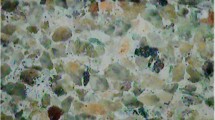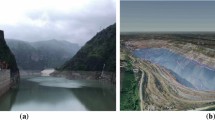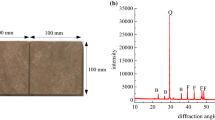Abstract
The shear behavior of rock is markedly affected by the presence of water. To study the influence of water on the shear behaviors of rock, a series of direct shear tests were conducted on intact sandstone specimens with different water soaking durations (from dried to saturated) under three levels of normal stresses. Before direct shear tests were performed, water absorption experiments were conducted to guide the different levels of water saturation required for the direct shear tests. The influences of water on shear stress-shear strain responses and peak and residual shear strength envelopes were investigated. The results show that soaking duration significantly impairs the peak and residual shear strengths and other shear properties (e.g., cohesion, friction angle and shear stiffness). The reductions in fracture energy and friction coefficient and the chemical and corrosive deterioration are the main mechanisms for the decrease of intact sandstone’s shear strength. A novel observation is that the failure patterns of specimens are sensitive to different water distributions. The results provided in this study reveal that the stability of rock engineering is affected by changes in water levels.













Similar content being viewed by others
References
Atapour H, Moosavi M (2014) The influence of shearing velocity on shear behavior of artificial joints. Rock Mech Rock Eng 47:1745–1761
Barton N (1976) The shear strength of rock and rock joints. Int J Rock Mech Min Sci Geomech Abs 13:255–279
Barton NR, Choubey V (1977) The shear strength of rock joints in theory and practice. Rock Mech Rock Eng 10:1–54
Baud P, Zhu W, Wong TF (2000) Failure mode and weakening effect of water on sandstone. J Geophys Res-Sol Ea 105:16371
Byerlee J (1978) Friction of rocks. Pure Appl Geophys 116:615–626
Cai X, Zhou ZL, Liu KW, Du XM, Zang HZ (2019) Water-weakening effects on the mechanical behavior of different rock types: phenomena and mechanisms. Appl Sci 9:4450
Cai X, Zhou ZL, Du XM (2020a) Water-induced variations in dynamic behavior and failure characteristics of sandstone subjected to simulated geo-stress [J]. Int J Rock Mech Min Sci 130: 104339
Cai X, Zhou ZL, Zang HZ, Song ZY (2020b) Water saturation effects on dynamic behavior and microstructure damage of sandstone: phenomena and mechanisms [J]. Eng Geol 276: 105760
Çobanoğlu İ, Çelik SB, Dinçer İ, Alkaya D (2009) Core size and time effects on water absorption values of rock and cement mortar samples. B Eng Geol Environ 68:483–489
Dyke CG, Dobereiner L (1991) Evaluating the strength and deformability of sandstones. Int J Rock Mech Min Sci Geomech Abs 24:123–134
Eppes MC, Keanini R (2017) Mechanical weathering and rock erosion by climate-dependent subcritical cracking. Rev Geophys 55:470–508
Erguler ZA, Ulusay R (2009) Water-induced variations in mechanical properties of clay-bearing rocks. Int J Rock Mech Min Sci 46:355–370
Freiman SW (1984) Effects of chemical environments on slow crack growth in glasses and ceramics. J Geophys Res-Sol Ea 89:4072–4076
Gong FQ, Luo S, Lin G, Li XB (2020) Evaluation of shear strength parameters of rocks by preset angle shear, direct shear and triaxial compression tests. Rock Mech Rock Eng. https://doi.org/10.1007/s00603-020-02050-1
Handin J, Rex V, Hager J, Melvin F, Feather JN (1963) Experimental deformation of sedimentary rocks under confining pressure : pore pressure tests. Am Assoc Pet Geol Bull 47:717–755
Hatheway AW (2009) The complete ISRM suggested methods for rock characterization, testing and monitoring; 1974–2006. Environ Eng Geosci 15:47–48
Hawkins AB, McConnell BJ (1992) Sensitivity of sandstone strength and deformability to changes in moisture content. Q J Eng Geol Hydroge 25:115–130
Homand S, Shao JF (2000) Mechanical behaviour of a porous chalk and effect of saturating fluid. Mech Cohes-frict Mat 5:583–606
Horn HM, Deere DU (1962) Frictional characteristics of minerals. Geotechnique 12:319–335
ISRM (2009) The complete ISRM suggested methods for rock characterization, testing and monitoring: 1974–2006. In: Ulusay R, E HJ, eds. Suggested Methods Prepared by the Commission on Testing Methods, International Society for Rock Mechanics. Compilation Arranged by the ISRM Turkish National Group, Ankara, Turkey
Jiang Q, Cui J, Feng XT, Jiang YJ (2014) Application of computerized tomographic scanning to the study of water-induced weakening of mudstone. B Eng Geol Environ 73:1293–1301
Kim T, Jeon S (2019) Experimental study on shear behavior of a rock discontinuity under various thermal, hydraulic and mechanical conditions. Rock Mech Rock Eng 52:2207–2226
Li B, Ye XN, Dou ZH, Zhao ZH, Li YC, Yang Q (2020) Shear strength of rock fractures under dry, surface wet and saturated conditions. Rock Mech Rock Eng. https://doi.org/10.1007/s00603-020-02061-y
Li Z, Sheng Y, Reddish DJ (2005) Rock strength reduction and its potential environmental consequences as a result of groundwater rebound. Proceedings of the 9th International Mine Water Congress, Spain:513–519
Liu BL, Yang HQ, Karekal S (2020a) Effect of water content on argillization of mudstone during the tunnelling process. Rock Mech Rock Eng 53:799–813
Liu HL, Zhu WC, Yu YJ, Xu T, Li RF, Liu XG (2020b) Effect of water imbibition on uniaxial compression strength of sandstone [J]. Int J Rock Mech Min Sci 127: 104200
Mehrishal S, Sharifzadeh M, Shahriar K, Song J-J (2016) An experimental study on normal stress and shear rate dependency of basic friction coefficient in dry and wet limestone joints. Rock Mech Rock Eng 49:4607–4629
Pellet FL, Keshavarz M, Boulon M (2013) Influence of humidity conditions on shear strength of clay rock discontinuities. Eng Geol 157:33–38
Qi S, Yue Z, Wu F, Chang Z (2009) Deep weathering of a group of thick argillaceous limestone rocks near Three Gorges Reservoir, Central China. Int J Rock Mech Min Sci 46:929–939
Rajabzadeh MA, Moosavinasab Z, Rakhshandehroo G (2012) Effects of rock classes and porosity on the relation between uniaxial compressive strength and some rock properties for carbonate rocks. Rock Mech Rock Eng 45:113–122
Singh Y, Bhat GM, Sharma V, Pandita SK, Thakur KK (2012) Reservoir induced landslide at Assar, Jammu and Kashmir: A case study. J Geol Soc India 80:435–439
Stark TD, Duncan JM (1991) Mechanisms of strength loss in stiff clays. J Geotech Eng 117:139–154
Talesnick M, Shehadeh S (2007) The effect of water content on the mechanical response of a high-porosity chalk. Int J Rock Mech Min Sci 44:584–600
Tang SB (2018) The effects of water on the strength of black sandstone in a brittle regime. Eng Geol 239:167–178
Tang SB, Yu CY, Heap MJ, Chen PZ, Ren YG (2018) The influence of water saturation on the short- and long-term mechanical behavior of red sandstone. Rock Mech Rock Eng 51:2669–2687
Tang ZC, Zhang QZ, Peng J, Jiao YY (2019) Experimental study on the water-weakening shear behaviors of sandstone joints collected from the middle region of Yunnan province, P.R. China. Eng Geol 258:1–12
Ulusay R, Karakul H (2016) Assessment of basic friction angles of various rock types from Turkey under dry, wet and submerged conditions and some considerations on tilt testing. B Eng Geol Environ 75:1683–1699
Vásárhelyi B (2005) Statistical analysis of the influence of water content on the strength of the miocene limestone. Rock Mech Rock Eng 38:69–76
Vásárhelyi B, Ván P (2006) Influence of water content on the strength of rock. Eng Geol 84:70–74
Van Eeckhout EM, Peng SS (1975) The effect of humidity on the compliances of coal mine shales. Int J Rock Mech Min Sci Geomech Abs 12:335–340
Wong LNY, Maruvanchery V, Liu G (2016) Water effects on rock strength and stiffness degradation. Acta Geotech 11:713–737
Yilmaz I (2010) Influence of water content on the strength and deformability of gypsum. Int J Rock Mech Min Sci 47:342–347
Zhang H, Tannant D, Jing H, Nunoo S, Niu S, Wang S (2015) Evolution of cohesion and friction angle during microfracture accumulation in rock. Nat Hazards 77:497–510
Zhao J (2000) Applicability of Mohr-Coulomb and Hoek-Brown strength criteria to the dynamic strength of brittle rock. Int J Rock Mech Min Sci 37:1115–1121
Zhao ZH, Yang J, Zhou D, Chen YF (2017) Experimental investigation on the wetting-induced weakening of sandstone joints. Eng Geol 225:61–67
Zhong C, Zhang Z, Ranjith PG, Lu Y, Choi X (2019) The role of pore water plays in coal under uniaxial cyclic loading. Eng Geol 257. https://doi.org/10.1016/j.enggeo.2019.05.002
Zhou Z, Cai X, Cao W, Li X, Xiong C (2016) Influence of water content on mechanical properties of rock in both saturation and drying processes. Rock Mech Rock Eng 48:3009–3025
Zhou Z, Cai X, Ma D, Chen L, Wang S, Tan L (2018) Dynamic tensile properties of sandstone subjected to wetting and drying cycles. Constr Build Mater 182:215–232
Funding
This project was financially supported by the National Key Research and Development Program (2017YFC1503102) and the National Natural Science Foundation of China (41941018, 51874065 and U1903112).
Author information
Authors and Affiliations
Corresponding author
Ethics declarations
Conflict of Interest
The authors declare no competing interests.
Rights and permissions
About this article
Cite this article
Liang, X., Tang, S., Tang, C. et al. The influence of water on the shear behaviors of intact sandstone. Bull Eng Geol Environ 80, 6077–6091 (2021). https://doi.org/10.1007/s10064-021-02315-1
Received:
Accepted:
Published:
Issue Date:
DOI: https://doi.org/10.1007/s10064-021-02315-1




